Earthquakes are relatively rare in Arizona, but at about 11:20 p.m. on Nov. 1, three 4.1 magnitude earthquakes hit the Phoenix area. According to the Arizona Geological Survey, the epicenter was Black Canyon City about 20 miles north of Phoenix. The jolts also were felt in metro Phoenix and Camp Verde, and as far away as Queen Creek. The Geological Survey reported that the quakes were small and didn’t rupture the ground, but aftershocks were expected for the next few days, many too small to feel.
Another earthquake was closer to home. A 3.0 magnitude temblor hit at 6:50 a.m. in the morning on Nov. 2 across the lake from Lake Havasu City. The quake was about 22 miles south-southwest of Needles, Calif., about 25 miles west-northwest of Lake Havasu City.
The last noticeable earthquake in Arizona was in December 2014, when a 4.7 magnitude quake shook the Oak Creek Canyon fault near Sedona. Other quakes shook the Arizona-New Mexico border in June 2014.
Although Arizonans have little to worry about when it comes to big earthquakes or other natural disasters such as tornadoes or hurricanes, it still makes one think about what the local and state governments would do if there was, say, an earthquake large enough to cause significant damage. Is Lake Havasu City prepared for a natural disaster?
► Lake Havasu Fire Department
Handling the emergency management planning for Havasu is one of the duties of the city’s fire department. When asked what plans Lake Havasu has in place in case of a disaster, Lake Havasu City Fire Chief Dennis Mueller said the city works hand in hand with Mohave County emergency management division, and also with the state department of emergency management.
Mueller produced two thick binders. One was a resource guide Mueller compiled of every federal, state, county and city agency that might need to be contacted in any type of disaster, including law enforcement agencies, fire, medical, social, the private sector, the media and more.
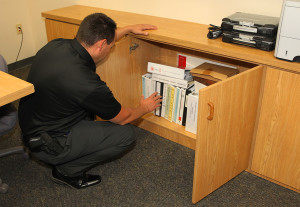
LHCPD Public Information Officer Kirk Cesena looks through handbooks that outline emergency protocol. Jillian Danielson/RiverScene
“And this one is the city’s EOP, Emergency Operations Plan,” Mueller said, holding up the second binder. “But it’s only for city use; it’s not available to the public for obvious reasons. If a perpetrator were able to see exactly what our plans were in case of, for example, a bombing, he would know how we would respond and plan accordingly.
“The book lists key people to call in, such as the Red Cross, has instructions for setting up shelters and how to run them, and also describes evacuation plans for the city.” Mueller added. “It lists plans for disasters such as fire, mass casualty, a pandemic event, major flooding, hazards such as acid and hazardous materials leaks, and earthquakes. Lake Havasu is in an earthquake Zone 2; Southern California is a Zone 1, which is the highest risk.”
“We also coordinate with the school district, which has its own emergency plans,” Mueller continued. “And we’re working with churches to help them develop emergency plans also. If several groups have the ability to contact large numbers of members, it saves time by allowing us to contact the church, which would then contact all of their members.”
Mueller urges citizens to take a look at the extensive emergency guide on the city website which helps families to develop a plan for their own home. Visit http://www.lhcaz.gov/brochures/fire/emergencyPreparednessGuide.pdf
Lake Havasu has been recognized in the past for its emergency plans by FEMA and the National League of Cities. The city also assisted the Bureau of Reclamation’s planning efforts for catastrophic dam failure along the Colorado River.
Mueller said he has heard of people saying that if the Hoover Dam failed, the flooding would rise to Acoma Avenue in Havasu.
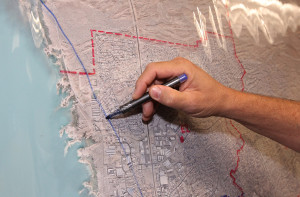
Lake Havasu Fire Department Chief Dennis Mueller draws on a map of Lake Havasu outlining flood plain areas. Jillian Danielson/RiverScene
“Not possible,” he said. “According to the Bureau of Reclamation, both Hoover Dam and Davis Dam would have to completely fail at the same time in order for water to reach Havasu, and then the highest it could possibly go would be Highway 95. The waves would be as high as 4 to 8 feet. But it’s just not possible for the flood waters to go as high as Acoma. Even the possibility of water reaching the highway is extremely remote, as both dams would have to be completely full.”
“Also, Needles plays a big part in such an event,” Mueller added. “The flood waters would first hit the Willow fire area (Topock/Mohave Valley) and spread out over a very large area there before reaching Havasu.”
Mueller further explained the local dam system.
“The dam system along the Colorado River starts with the Glen Canyon Dam which holds back Lake Powell. If this dam failed, it would send flood waters down the 302 miles from Glen Canyon Dam to Hoover Dam. With any dam failures or issues, the Bureau of Reclamation (BOR) would notify all the dams below of the situation at hand and would possibly activate their emergency action plans. You may want to contact the BOR and see if they have any information for you.
“Hoover Dam is the next dam in the system. It holds back Lake Mead, which is approximately 35 to 40 feet below its normal level. By the time the waters of Lake Powell hit Lake Mead, Hoover Dam may or may not have released more water from its flood gates based on the amount of water Lake Mead could hold from Lake Powell. If Hoover Dam failed, it would cause flood waters to head to Lake Mohave above Davis Dam.
“Davis Dam is approximately 70 miles below Hoover Dam. It holds the waters of Lake Mohave. If Hoover Dam failed, the BOR again would initiate their emergency action plans and would probably require the flood gates to be opened at Davis Dam in an attempt to reduce the impact of water coming from Hoover Dam. If Davis Dam failed, it would send flood waters toward Parker Dam, which is below Lake Havasu.
“Parker Dam is approximately 88 miles below Davis Dam and it holds back the waters of Lake Havasu. Below Parker Dam are a couple of smaller irrigation dams that control the flow of water down the Colorado River until it hits the ocean.
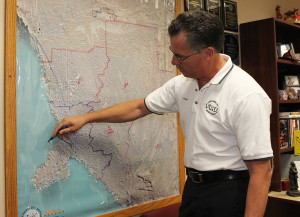
Lake Havasu Fire Department Chief Dennis Mueller draws on a map of Lake Havasu outlining flood plain areas. Jillian Danielson/RiverScene
“As far as the impact of flood waters here in Lake Havasu, both Hoover Dam and Davis Dam would need to fail in order for us to see an impact, which would be minimal due to the amount of water in both Lake Mead and Lake Mohave. For us to see a larger impact on our Lake and segments of our community, both Lake Mead and Lake Mohave would need to be at maximum capacity for us to see any major issues. As we know, both these lakes are well below their maximum levels.
“If Parker Dam failed, our lake level would drop drastically and problems would ensue from low water levels, but we would not experience any flooding, of course.
“The major concern in a flood would be the effect on our treatment plant on the island,” the fire chief continued, “but we’ve been able to mitigate that possible event. Another big concern would be the contamination of our water supply, but we’ve already planned for that possibility.”
Asked about the probability of a large-scale disaster in or near Havasu, Mueller responded, “We’re a pretty protected community here. There’s little likelihood of disasters such as wildfires or tornadoes, but we still need to be prepared. During a disaster, 911 would be inundated. Can you sit and wait to get through, or will you be prepared? I’ve always said ‘Plan for the worst but hope for the best.’”
In the event of an earthquake, Mueller said we have little reason for concern. “For many years now, all buildings in Havasu have to be reinforced and designed to withstand high impact.
“There are people working for the city who have your best interests in mind,” Mueller said, “and we’re always studying ways to improve our reaction to emergencies.”
► Lake Havasu City Police Department
Lake Havasu City Police Department Public Information Officer Kirk Cesena said the department operates under the ICS (Incident Command System) in cases of emergencies.
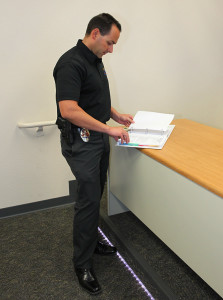
LHCPD Public Information Officer Kirk Cesena looks through a handbook which outlines emergency protocol. Jillian Danielson/RiverScene
The Incident Command System is a management system designed to enable effective and efficient domestic incident management by integrating a combination of facilities, equipment, personnel, procedures and communications operating within a common organizational structure. ICS is normally structured to facilitate activities in five major functional areas: command operations; planning; logistics; intelligence and investigations; finance and administration. It is a fundamental form of management, with the purpose of enabling incident managers to identify the key concerns associated with the incident — often under urgent conditions — without sacrificing attention to any component of the command system.
To narrow it down even further, Havasu PD has emergency operations plans and procedures in place that would guide them through an incident such as a major flood or disaster. The emergency management mission statement is “The mission of the emergency management program in Lake Havasu City is to provide procedural guidelines to the staff during disaster situations, and assist them in the delivery of emergency response and recovery issues.”
The first step is to activate the Emergency Operations Center (EOC), which is located at the police department. They also have an EOC trailer that can be set up at certain locations for a mobile command center.
The next step would be to recall police and fire personnel as needed. Once the EOC is activated and the Incident Commander is in place, organizing the ICS structure as needed begins. Some situations only require an operations branch; more severe situations may require more branches.
The operations branch puts boots to the floor and begins rescue efforts, evacuations, or assembles tactical teams to diffuse a threat. The more frequent EOC activations are in response to major monsoons or missing persons. During monsoons that cause major damage (such as the monsoon last year that downed several power lines) the EOC is activated and personnel from the PD, fire department, city division personnel, electric company are assigned to answer media requests. In the field, certain branches take care of issues such as blocking roadways (PD personnel), rescue efforts (PD and Fire), downed power lines (electric company), clearing debris from streets (city streets personnel), activating shelters (Red Cross, Salvation Army, C.E.R.T. team).
If the disaster is so large that city resources could not sustain the disaster, PD would resort to a multi-agency response. When outside resources start arriving to the EOC, they would be placed into the appropriate branch of the ICS.
This is a systematic approach to responding to small- or large-scale events. No matter how small or large the event, the Incident Command System can be used.
The law enforcement function during flooding would be the following:
• Receive/verify flood reports
• Assist in alerting the public of hazards and actions to take.
• Assist in evacuations as required 1. Door to door 2. Evacuate people with special needs
• Assist in maintaining order with shelters
• Assist in conducting rescue operations as needed.
• Recall off-duty personnel as needed.
The law enforcement function during an earthquake would be the following:
• Verify damage and injury or trapped victims.
• Alert disaster preparedness coordinator
• Secure and control access to disaster / potential disaster areas.
• Assist in alerting the public of hazards and actions to take.
• Assist in evacuations.
The law enforcement function for a bombing or terrorist act would be the following:
• Secure and control access to the area
• Evacuate designated areas
• Provide traffic control
• Provide crowd control
• Search for hazardous devices
• Provide hostage negotiations
• Collect evidence
• Investigate the crime scene(s)
• Provide shelter security
• Call in off duty personnel
• Notify federal agencies if needed.
► The Red Cross
Trudy Thompson Rice is the Chief Communications Officer for the American Red Cross for the Arizona-New Mexico-El Paso Region. The Red Cross has an office in Lake Havasu, at 1947 McCulloch, No. 104, although it is staffed by volunteers and therefore not always open. Rice said each county in Arizona has an emergency manager. That person works with emergency response agencies like the Red Cross, law enforcement, fire departments, the Salvation Army and others, to ensure there is a plan in place to prepare for, respond to and recover from disasters.
Rice provided the following information about how the Red Cross operates.
In Mohave County, the emergency manager is Byron Steward. He and his staff work closely with several organizations as well as with city, state and federal governments.
If there is an emergency that requires people to leave their homes, like evacuation because of a wildfire, the Mohave County Emergency Manager calls the Red Cross, which activates volunteers there locally. They provide emergency sheltering, feeding and disaster-related emotional support to those displaced. They open shelters in schools, churches and other places where they have shelter agreements in place. Shelters have to meet certain standards like ADA compliance, have showers, and other amenities. They staff the shelters with trained volunteers, and provide meals, water, coffee and basic medical help (such as replace lost medications).
Home fires are the most common emergency the Red Cross responds to — one about every 10 hours across Arizona.
Rice would like everyone to know about the Red Cross Emergency App. It has information on earthquakes, hurricanes, tornadoes, wildfires, first aid and floods. It’s free and available at the app store.
Rice also suggests visiting www.redcross.org to find preparedness tips.
► C.E.R.T.
Bob MacMillan is a former Los Angeles City fire chief and the team leader of the Lake Havasu City Community Emergency Response Team, or C.E.R.T. This team plays a very important part in serving the community in times of fire, flooding and other disasters. MacMillan provided the following information on the services C.E.R.T. provides.
“C.E.R.T. is available on a 24-hour basis. Two members carry a fire department pager 24/7. Staffing the Rehab Division for the fire department we average 12 to 15 responses a year to structure fires or other larger emergencies the department is involved in. To handle this type of a response, we use a ‘rotating’ call-out list so that every member gets an equal opportunity to respond, as normally we only need 10 members for a full rehab set up. C.E.R.T members are trained to drive the fire department rehab apparatus which is ready for emergency response.
“We also have a ‘full team’ call-out list that works similar to a telephone tree setup where selected members call a number of members on their list after being notified of the need for the full team. Normally we can know within 15 minutes how many team members are available to respond. We used this operation last Sunday when we were asked by the police department to assist in the search for a missing person. We put 15 members in the field in short order and searched door to door until sundown.
“Regarding advanced planning, the fire department has a large manual for dealing with emergency operations. The C.E.R.T. team is included in this manual for items such as staffing ‘Reception Centers’ and full ‘Shelters’ if the need arises. C.E.R.T. has surveyed all the schools and larger city buildings for shelter use. We are trained by the American Red Cross for shelter operations. C.E.R.T. members also are trained to assist first responders at Command Posts if needed.
“The C.E.R.T. team maintains an emergency response trailer that is loaded with tools, equipment and first aid supplies that we use when staffing first aid stations at the large events here in Lake Havasu. The trailer is available to respond anywhere in the county if we are requested by Mohave County Emergency Management.”
► Lake Havasu Unified School District
The Lake Havasu Unified School District has its own emergency preparedness plans in place. Aggie Wolter, District Emergency Response Coordinator, emphasizes that parents should not call the school in an emergency because it ties up communications with the fire and police departments.
“The schools will send out information to parents by the Blackboard Communication System,” Wolter said, “which uses email and cell phones. We will also notify local media of the emergency.”
Parents can access the District’s emergency preparedness plan by visiting http://www.havasu.k12.az.us/pdf/emergency_preparedness.pdf.
The District sends out the following letter to all parents at the beginning of the school year.
Lake Havasu Unified School District No.1
Emergency Preparedness Parent Letter
Dear Parents and Guardians:
Should an emergency or disaster situation ever arise in our area while school is in session, we want you to be aware that the schools have made preparations to respond effectively to such situations. In fact, public schools in Arizona are built to meet stringent construction standards and they may be safer than your own home in the event of a disaster.
Should we have a major disaster during school hours, your student(s) will be cared for at the school. Our School District has a detailed disaster plan which has been formulated to respond to a major catastrophe. Your cooperation is necessary in any emergency.
1. Do not telephone the school. Telephone lines may be needed for emergency communication.
2. Do not attempt to reach your student by cell phone as this may put your student at further risk depending on the emergency and cell phone lines may be needed for emergency communication.
3. In the event of a serious emergency, students will be kept at their schools until they are picked up by an identified, responsible adult who has been identified as such on a School District emergency card which is required to be filled out by parents at the beginning of every school year. Please be sure you consider the following criteria when you authorize another person to pick up your child at school: He/she is 18 years of age or older. He/she is usually home during the day. He/she could walk to school, if necessary. He/she is known to your child. He/she is both aware and able to assume this responsibility.
4. Turn your radio to KAAA, KFLG-FM, KNKK-M, KSTAR-AM, KZZZ-AM, KJJJ, KNTR, KAAA, KFLG-FM, KNKKM, KSTAR-AM, and KZZZ-AM for emergency announcements. If students are to be kept at school, radio stations will be notified. If electrical service and internet services are not affected, information will be posted on school website which can be accessed through district website at www.havasu.k12.az.us.
5. In addition, information regarding day-to-day school operations will be available by calling the District Office at 505-6900.
6. Impress upon your children the need for them to follow the directions of any school personnel in times of an emergency. Students will be released only to parents and persons identified on the School District Emergency Card. During an extreme emergency, students will be released at designated reunion gates located on school campuses. These will be identified with signs or posters.
Parents should become familiar with the School Emergency Disaster Plan and be patient and understanding with the student release process. Please instruct your student to remain at school until you or a designee arrives. Because local telephone service may be disrupted, also list an out-of-state contact on the emergency card, as calls may still be made out of the area while incoming calls are affected. The decision to keep students at school will be based upon whether or not streets in the area are open. If this occurs, radio stations will be notified. In the event that a natural disaster takes place during the time that students are being transported, students will be kept on the bus and the driver will ask for assistance through radio contact with the school and district personnel. Any child who is home waiting for the bus will not be picked up (if roads are impassable) and remains the responsibility of the parent or guardian. In the event a natural disaster occurs in the afternoon, the driver will make every attempt to continue delivering the students to their homes. Should road conditions prevent the driver from delivering students to their home or to school in the morning, the students will be delivered to the nearest school site and that school will communicate with the home school to inform them of the students’ whereabouts.
In case of a hazardous release event (chemical spill) near the school area, Shelter-in-Place procedures will be implemented to provide in place protection. All students and staff will clear the fields, report to their rooms and all efforts will be made to prevent outside air from entering classrooms during the emergency. “Shelter-in-Place” signs will be placed in classroom windows or hung outside classroom doors during a drill or emergency. Students arriving at school during a Shelter-in-Place drill or event should report to the school office or to a previously designated area at the school because classrooms will be inaccessible. When the dangerous incident has subsided, an all-clear signal will be given.
Should an emergency or disaster situation ever arise while school is not in session requiring a school closure, the following steps will be taken to notify and keep the community aware of status. Radio and local TV stations will be notified. Please turn your radio to KAAA, KFLG-FM, KNKK-M, KSTAR-AM, KZZZAM, KJJJ, KNTR, KAAA, KFLG-FM, KNKK-M, KSTAR-AM, and KZZZ-AM for emergency announcements. Turn your television to station Channels 25 and 45 for public announcements. Information will be posted on school website which can be accessed through district website at www.havasu.k12.az.us. Staff will be posted outside of school to communicate school closure. If your student rides a school bus, the bus driver will notify your child at the bus stop. Emergency phone call system will be activated and parents will be notified. In addition, school marquis will be used to communicate closure. Please discuss these matters with your immediate family. Planning ahead will help alleviate concern during emergencies. For more information on how your family can be better prepared for emergencies at home, please contact Mohave County Public Health Department or log on to www.HealthELinks.com.
Sincerely,
Aggie Wolter
District Emergency Response Coordinator
Feature Photo Cutline: The LHPD Emergency Operations Center
Coming next: Part 2 – “What You Can Do In Any Emergency”







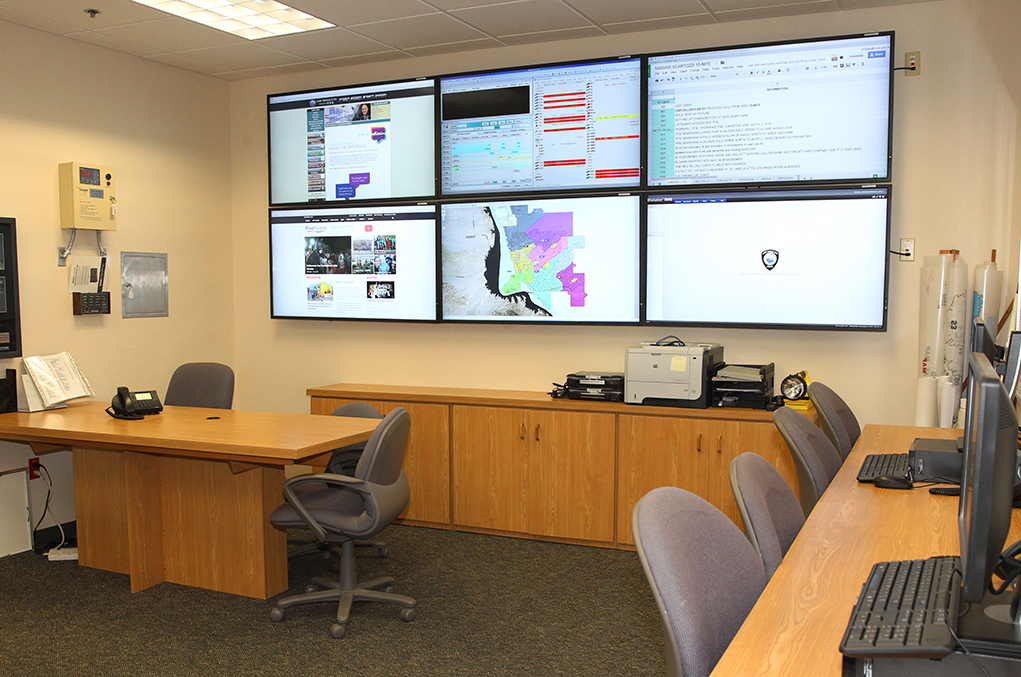



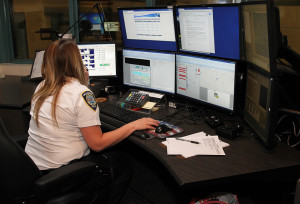







No Comments » Comments: